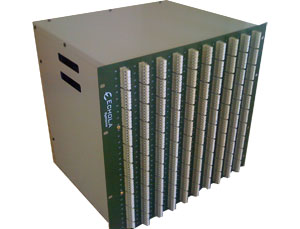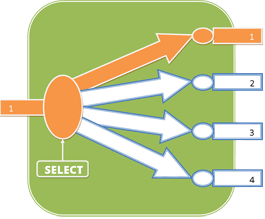| OS214 | OS414 | OS3012 |
 OS214 - 1x4 duplex switch
OS214 - 1x4 duplex switch |
 OS414 - 4(1x4) duplex switch
OS414 - 4(1x4) duplex switch
|
 OS3012 - 100(1x2) switch
OS3012 - 100(1x2) switch
|
Development/test engineers use optical resource-sharing switches to time-share one expensive optical device with many other optical devices. Sharing switches saves thousands of dollars in capital equipment by effectively using underutilized, costly optical equipment. For example, a typical application involves sharing an expensive 100GE BERT or a protocol analyzer with 100GE Ethernet uplinks in production automation and test environments. Another application example is sharing an expensive Fibre Channel switch with other Fibre Channel devices in test and development testbeds.
1xN optical switches have one input and multiple outputs. The input light can be switched from input to any one of the outputs at any given time. The switching takes place in less than 5 ms. The n(1xN) optical switches have multiple (n)1xN switches in a single enclosure controlled by one network management module. These 1xN switches are Layer-1 optical switches that provide transparent connectivity, so you do not need expensive transceivers (e.g., 10GE SFP) to connect to other optical devices. They can be used with any protocols (Fibre Channel, Ethernet, SONET, etc.) and at any speed (1G, 4G, 10G, 40G, etc.), unlike OEO (2R/3R) devices that require expensive transceivers for each port. In addition, the transparent optical layer connectivity allows a unit under testing to be tested without introducing any latency.

The traditional 1xN switches available in the market today are not directly manageable through a network. Users must have a dedicated computer and software driver to connect to their GPIB or RS232 management interface, which increases the total cost of ownership and restricts access to a single user. GPIB and RS232 pose severe issues for use in today's complex regression tests and test automation environments where multiple users or applications need to share the same resource. Additionally, the duplex functionality does not usually come in the standard configuration: you have to custom order or connect two such 1xN devices in parallel and go through cumbersome configuration and management.
Another problem with traditional 1xN optical switches is that they cannot be cascaded. For instance, OS214 allows users to configure many OS214 devices in series, only limited by the optical devices' transmit power and OS214's total insertion loss, to share many more optical devices. The following diagram shows how two OS214 switches can be connected to obtain one duplex 1x7 virtual switch. The standard switch models in this category include OS214 (1x4 duplex or 2x8), OS218 (1x8 duplex or 2x16), and OS3012 100(1x2) duplex, which is 100(2x4). For custom configurations and prices, contact sales@echola.com.

For more details on os214, click here
For more details on os414, click here
For more details on os3012, click here
